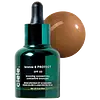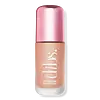What's inside
What's inside
 Key Ingredients
Key Ingredients

 Benefits
Benefits

 Concerns
Concerns

 Ingredients Side-by-side
Ingredients Side-by-side

Zinc Oxide 12%
Cosmetic ColorantWater
Skin ConditioningC12-15 Alkyl Benzoate
AntimicrobialButyloctyl Salicylate
Skin ConditioningLauryl PEG-8 Dimethicone
Isododecane
EmollientPropanediol
SolventIron Oxides
CI 77491
Cosmetic ColorantSynthetic Fluorphlogopite
Dimethicone
EmollientNiacinamide
SmoothingPolymethylsilsesquioxane
Isohexadecane
EmollientTrilaureth-4 Phosphate
EmulsifyingDimethiconol
EmollientMica
Cosmetic ColorantCaprylyl Methicone
Skin ConditioningOctyldodecyl Neopentanoate
EmollientLauryl PEG-10 Tris(Trimethylsiloxy)Silylethyl Dimethicone
EmulsifyingCI 77492
Cosmetic ColorantSodium Chloride
MaskingPhenoxyethanol
PreservativeBisabolol
MaskingDisteardimonium Hectorite
StabilisingCI 77499
Cosmetic ColorantCaprylyl Glycol
EmollientAllantoin
Skin ConditioningTitanium Dioxide
Cosmetic ColorantEthylhexylglycerin
Skin ConditioningHexylene Glycol
EmulsifyingPropylene Carbonate
SolventPolyglyceryl-4 Diisostearate/Polyhydroxystearate/Sebacate
EmulsifyingPEG-10
HumectantTetrasodium Glutamate Diacetate
Hydrogenated Lecithin
EmulsifyingTin Oxide
AbrasiveSodium Hydroxide
BufferingZinc Oxide 12%, Water, C12-15 Alkyl Benzoate, Butyloctyl Salicylate, Lauryl PEG-8 Dimethicone, Isododecane, Propanediol, Iron Oxides, CI 77491, Synthetic Fluorphlogopite, Dimethicone, Niacinamide, Polymethylsilsesquioxane, Isohexadecane, Trilaureth-4 Phosphate, Dimethiconol, Mica, Caprylyl Methicone, Octyldodecyl Neopentanoate, Lauryl PEG-10 Tris(Trimethylsiloxy)Silylethyl Dimethicone, CI 77492, Sodium Chloride, Phenoxyethanol, Bisabolol, Disteardimonium Hectorite, CI 77499, Caprylyl Glycol, Allantoin, Titanium Dioxide, Ethylhexylglycerin, Hexylene Glycol, Propylene Carbonate, Polyglyceryl-4 Diisostearate/Polyhydroxystearate/Sebacate, PEG-10, Tetrasodium Glutamate Diacetate, Hydrogenated Lecithin, Tin Oxide, Sodium Hydroxide
Water
Skin ConditioningDimethicone
EmollientSilica
AbrasiveIsododecane
EmollientLauroyl Lysine
Skin ConditioningMica
Cosmetic ColorantIsohexadecane
EmollientLauryl PEG-10 Tris(Trimethylsiloxy)Silylethyl Dimethicone
EmulsifyingTrisiloxane
Skin ConditioningButylene Glycol
HumectantGlycerin
HumectantBis-Hydroxyethoxypropyl Dimethicone/Ipdi Copolymer Ethylcarbamate
Aluminum/Magnesium Hydroxide Stearate
Emulsion StabilisingSodium Chloride
MaskingSorbitan Caprylate
EmulsifyingSorbitan Isostearate
EmulsifyingPersea Gratissima Fruit Extract
EmollientNiacinamide
SmoothingSodium Hyaluronate
HumectantSaccharomyces/Xylinum/Black Tea Ferment
Skin ConditioningHydroxyethylcellulose
Emulsion StabilisingTocopherol
AntioxidantPhenoxyethanol
PreservativeSodium Citrate
BufferingCitric Acid
BufferingBiotin
AntiseborrhoeicDimethicone/Vinyl Dimethicone Crosspolymer
Skin ConditioningDi-C12-13 Alkyl Tartrate
EmollientAlcohol
AntimicrobialStearalkonium Bentonite
Gel FormingCaprylic/Capric Triglyceride
MaskingPotassium Sorbate
PreservativeSodium Benzoate
MaskingSodium Dehydroacetate
PreservativeTocopheryl Acetate
AntioxidantAlcohol Denat.
AntimicrobialPhytic Acid
CI 77891
Cosmetic ColorantCI 77491
Cosmetic ColorantWater, Dimethicone, Silica, Isododecane, Lauroyl Lysine, Mica, Isohexadecane, Lauryl PEG-10 Tris(Trimethylsiloxy)Silylethyl Dimethicone, Trisiloxane, Butylene Glycol, Glycerin, Bis-Hydroxyethoxypropyl Dimethicone/Ipdi Copolymer Ethylcarbamate, Aluminum/Magnesium Hydroxide Stearate, Sodium Chloride, Sorbitan Caprylate, Sorbitan Isostearate, Persea Gratissima Fruit Extract, Niacinamide, Sodium Hyaluronate, Saccharomyces/Xylinum/Black Tea Ferment, Hydroxyethylcellulose, Tocopherol, Phenoxyethanol, Sodium Citrate, Citric Acid, Biotin, Dimethicone/Vinyl Dimethicone Crosspolymer, Di-C12-13 Alkyl Tartrate, Alcohol, Stearalkonium Bentonite, Caprylic/Capric Triglyceride, Potassium Sorbate, Sodium Benzoate, Sodium Dehydroacetate, Tocopheryl Acetate, Alcohol Denat., Phytic Acid, CI 77891, CI 77491
Ingredients Explained
These ingredients are found in both products.
Ingredients higher up in an ingredient list are typically present in a larger amount.
Ci 77491 is also hydrated iron III oxide. It's sole purpose is to give a red/pink hue to products.
Iron III oxides are classified as inorganic chemicals for coloring.
Synthetically created Ci 77491 is considered safer than those naturally found. This is because the synthetically created version may contain less impurities. Iron oxides are generally non-toxic and non-allergenic.
Learn more about CI 77491Dimethicone is a type of synthetic silicone created from natural materials such as quartz.
What it does:
Dimethicone comes in different viscosities:
Depending on the viscosity, dimethicone has different properties.
Ingredients lists don't always show which type is used, so we recommend reaching out to the brand if you have questions about the viscosity.
This ingredient is unlikely to cause irritation because it does not get absorbed into skin. However, people with silicone allergies should be careful about using this ingredient.
Note: Dimethicone may contribute to pilling. This is because it is not oil or water soluble, so pilling may occur when layered with products. When mixed with heavy oils in a formula, the outcome is also quite greasy.
Learn more about DimethiconeIsododecane is a fragrance, emollient, and solvent.
As an emollient, it helps your skin stay soft and hydrated. Emollients help trap moisture into your skin.
Isododecane's role as a solvent makes it a great texture enhancer. It spreads smoothly on skin and does not leave a sticky feeling behind. Isododecane also helps prevent color transfer in makeup products.
Isododecane is not absorbed into skin.
Learn more about IsododecaneIsohexadecane is added to enhance texture, emulsify, and to help cleanse. It is an isoparrafin. It is a component of petrolatum.
Due to its large size, Isohexadecane is not absorbed by the skin. Instead, it sits on top and acts as an emollient. Emollients help keep your skin soft and smooth by trapping moisture within.
Isohexadecane is often used in products designed to help oily skin. It is lightweight and non-greasy while helping to moisturize. When mixed with silicones, it gives a product a silky feel.
Learn more about IsohexadecaneLauryl PEG-10 Tris(Trimethylsiloxy)Silylethyl Dimethicone is a type of silicone.
Mica is a naturally occurring mineral used to add shimmer and color in cosmetics. It can also help improve the texture of a product or give it an opaque, white/silver color.
Serecite is the name for very fine but ragged grains of mica.
This ingredient is often coated with metal oxides like titanium dioxide. Trace amounts of heavy metals may be found in mica, but these metals are not harmful in our personal products.
Mica has been used since prehistoric times throughout the world. Ancient Egyptian, Indian, Greek, Roman, Aztec, and Chinese civilizations have used mica.
Learn more about MicaNiacinamide is a multitasking form of vitamin B3 that strengthens the skin barrier, reduces pores and dark spots, regulates oil, and improves signs of aging.
And the best part? It's gentle and well-tolerated by most skin types, including sensitive and reactive skin.
You might have heard of "niacin flush", or the reddening of skin that causes itchiness. Niacinamide has not been found to cause this.
In very rare cases, some individuals may not be able to tolerate niacinamide at all or experience an allergic reaction to it.
If you are experiencing flaking, irritation, and dryness with this ingredient, be sure to double check all your products as this ingredient can be found in all categories of skincare.
When incorporating niacinamide into your routine, look out for concentration amounts. Typically, 5% niacinamide provides benefits such as fading dark spots. However, if you have sensitive skin, it is better to begin with a smaller concentration.
When you apply niacinamide to your skin, your body converts it into nicotinamide adenine dinucleotide (NAD). NAD is an essential coenzyme that is already found in your cells as "fuel" and powers countless biological processes.
In your skin, NAD helps repair cell damage, produce new healthy cells, support collagen production, strengthen the skin barrier, and fight environmental stressors (like UV and pollution).
Our natural NAD levels start to decline with age, leading to slower skin repair, visible aging, and a weaker skin barrier. By providing your skin niacinamide, you're recharging your skin's NAD levels. This leads to stronger, healthier, and younger looking skin.
Another name for vitamin B3 is nicotinamide. This vitamin is water-soluble and our bodies don't store it. We obtain Vitamin B3 from either food or skincare. Meat, fish, wheat, yeast, and leafy greens contain vitamin B3.
The type of niacinamide used in skincare is synthetically created.
Learn more about NiacinamidePhenoxyethanol is a preservative that has germicide, antimicrobial, and aromatic properties. Studies show that phenoxyethanol can prevent microbial growth. By itself, it has a scent that is similar to that of a rose.
It's often used in formulations along with Caprylyl Glycol to preserve the shelf life of products.
Chances are, you eat sodium chloride every day. Sodium Chloride is also known as table salt.
This ingredient has many purposes in skincare: thickener, emulsifier, and exfoliator.
You'll most likely find this ingredient in cleansers where it is used to create a gel-like texture. As an emulsifier, it also prevents ingredients from separating.
There is much debate on whether this ingredient is comedogenic. The short answer - comedogenic ratings don't tell the whole story. Learn more about comegodenic ratings here.
The concensus about this ingredient causing acne seems to be divided. Research is needed to understand if this ingredient does cause acne.
Scrubs may use salt as the primary exfoliating ingredient.
Learn more about Sodium ChlorideWater. It's the most common cosmetic ingredient of all. You'll usually see it at the top of ingredient lists, meaning that it makes up the largest part of the product.
So why is it so popular? Water most often acts as a solvent - this means that it helps dissolve other ingredients into the formulation.
You'll also recognize water as that liquid we all need to stay alive. If you see this, drink a glass of water. Stay hydrated!
Learn more about Water